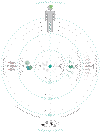Recycling side-effects into clinical markers for drug repositioning
- PMID: 22283977
- PMCID: PMC3334551
- DOI: 10.1186/gm302
Recycling side-effects into clinical markers for drug repositioning
Abstract
Side-effects are the unintended consequence of therapeutic treatments, but they can also be seen as valuable read-outs of drug effects in humans; these effects are difficult to infer or predict from pre-clinical models. Indeed, some studies suggest that drugs with similar side-effect profiles may also share therapeutic properties through related mechanisms of action. A recent publication exploits this concept to systematically investigate new indications for already marketed drugs, and presents a strategy to get the most out of the tiny portion of chemicals that have proved to be effective and safe.
Figures

Similar articles
-
Predicting unintended effects of drugs based on off-target tissue effects.Biochem Biophys Res Commun. 2016 Jan 15;469(3):399-404. doi: 10.1016/j.bbrc.2015.11.095. Epub 2015 Dec 2. Biochem Biophys Res Commun. 2016. PMID: 26626077
-
Systematic drug repositioning based on clinical side-effects.PLoS One. 2011;6(12):e28025. doi: 10.1371/journal.pone.0028025. Epub 2011 Dec 21. PLoS One. 2011. PMID: 22205936 Free PMC article.
-
Drug voyager: a computational platform for exploring unintended drug action.BMC Bioinformatics. 2017 Feb 28;18(1):131. doi: 10.1186/s12859-017-1558-3. BMC Bioinformatics. 2017. PMID: 28241745 Free PMC article.
-
In silico drug repositioning based on drug-miRNA associations.Brief Bioinform. 2020 Mar 23;21(2):498-510. doi: 10.1093/bib/bbz012. Brief Bioinform. 2020. PMID: 30753359 Review.
-
In silico drug repositioning: from large-scale transcriptome data to therapeutics.Arch Pharm Res. 2019 Oct;42(10):879-889. doi: 10.1007/s12272-019-01176-3. Epub 2019 Sep 3. Arch Pharm Res. 2019. PMID: 31482491 Review.
Cited by
-
Prediction of Novel Drugs and Diseases for Hepatocellular Carcinoma Based on Multi-Source Simulated Annealing Based Random Walk.J Med Syst. 2018 Sep 1;42(10):188. doi: 10.1007/s10916-018-1038-y. J Med Syst. 2018. PMID: 30173379
-
Cogena, a novel tool for co-expressed gene-set enrichment analysis, applied to drug repositioning and drug mode of action discovery.BMC Genomics. 2016 May 27;17:414. doi: 10.1186/s12864-016-2737-8. BMC Genomics. 2016. PMID: 27234029 Free PMC article.
-
Label Propagation Prediction of Drug-Drug Interactions Based on Clinical Side Effects.Sci Rep. 2015 Jul 21;5:12339. doi: 10.1038/srep12339. Sci Rep. 2015. PMID: 26196247 Free PMC article.
-
Combining automatic table classification and relationship extraction in extracting anticancer drug-side effect pairs from full-text articles.J Biomed Inform. 2015 Feb;53:128-35. doi: 10.1016/j.jbi.2014.10.002. Epub 2014 Oct 13. J Biomed Inform. 2015. PMID: 25445920 Free PMC article.
-
Inferences of drug responses in cancer cells from cancer genomic features and compound chemical and therapeutic properties.Sci Rep. 2016 Sep 20;6:32679. doi: 10.1038/srep32679. Sci Rep. 2016. PMID: 27645580 Free PMC article.
References
-
- Lamb J, Crawford ED, Peck D, Modell JW, Blat IC, Wrobel MJ, Lerner J, Brunet JP, Subramanian A, Ross KN, Reich M, Hieronymus H, Wei G, Armstrong SA, Haggarty SJ, Clemons PA, Wei R, Carr SA, Lander ES, Golub TR. The Connectivity Map: using gene-expression signatures to connect small molecules, genes, and disease. Science. 2006;313:1929–1935. doi: 10.1126/science.1132939. - DOI - PubMed
LinkOut - more resources
Full Text Sources
Other Literature Sources

